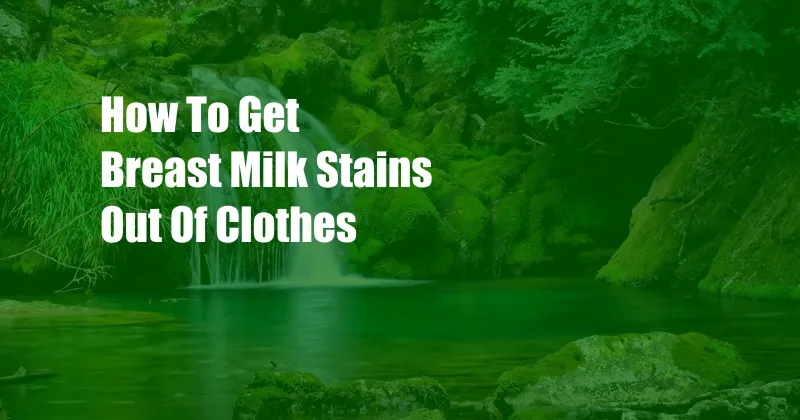
Breast Milk Stains: A Guide to Removal
The arrival of a newborn brings immense joy and a multitude of tasks, including frequent diaper changes and the inevitable spills of breast milk. While these spills are a testament to the nourishment a mother provides, they can also leave unsightly stains on the baby’s clothes. Fear not, as removing breast milk stains is a manageable task with the right approach.
Before embarking on the stain removal process, remember to act promptly as fresh stains are easier to remove than set-in ones. Additionally, test the chosen stain removal method on an inconspicuous area of the garment to ensure it doesn’t damage the fabric.
Stain Removal Techniques
Several effective methods can be employed to remove breast milk stains. Here’s a comprehensive guide:
Water and Mild Detergent
This is the most basic and often effective method. Rinse the garment under cold water to remove excess breast milk. Apply a small amount of mild detergent to the stain and gently rub it in. Allow it to sit for a few minutes before rinsing again. Repeat as necessary.
Lemon Juice
The acidity of lemon juice can help break down proteins in breast milk. Apply a few drops of lemon juice to the stain and let it rest for 15-20 minutes. Rinse the garment thoroughly to remove the lemon juice residue.
Baking Soda
Baking soda is another natural stain remover. Sprinkle a thick layer of baking soda over the stain and leave it overnight. In the morning, vacuum or brush off the baking soda and wash the garment as usual.
Hydrogen Peroxide
For white or light-colored fabrics, hydrogen peroxide can be an effective stain remover. Apply a few drops to the stain and let it sit for a few minutes. Rinse the garment thoroughly to remove any remaining hydrogen peroxide.
Commercial Stain Removers
There are also commercial stain removers specifically designed for breast milk. Follow the instructions on the product label carefully and test it on an inconspicuous area of the garment first.
Tips from Experts
In addition to the aforementioned methods, here are some additional tips from experts to enhance your stain removal success:
- Rinse with cold water: Always use cold water to rinse breast milk stains as hot water can set the stain.
- Avoid bleach: Bleach can damage fabrics and discolor them. Use it only as a last resort.
- Steam: Steaming the stain can help loosen the proteins in the breast milk, making it easier to remove.
- Sun exposure: Sunlight can help fade breast milk stains, but be sure to avoid exposing the garment to direct sunlight for too long, as this can also damage the fabric.
FAQs
To address common questions and concerns related to breast milk stain removal, here are some FAQs:
- Can breast milk stains set permanently?
- Can I use bleach to remove breast milk stains from colored fabrics?
- How do I prevent breast milk stains?
- Are there any special precautions for removing breast milk stains from delicate fabrics?
Yes, if not treated promptly, breast milk stains can set permanently.
No, bleach can damage colored fabrics and should only be used on white or light-colored fabrics.
Use a bib during feedings and change the baby’s clothes promptly after any spills.
Yes, always test the stain removal method on an inconspicuous area of the garment first to ensure it doesn’t damage the fabric.
Conclusion
Removing breast milk stains is an essential task for parents. By following the techniques and tips outlined in this guide, you can effectively tackle these stains and keep your baby’s clothes looking spotless. Remember, prompt action and the right approach are key to successful stain removal. If you encounter any persistent stains, don’t hesitate to seek professional cleaning services for assistance.
Are you interested in learning more about effective parenting techniques and household tips? Stay tuned for our future articles and connect with us to stay informed.